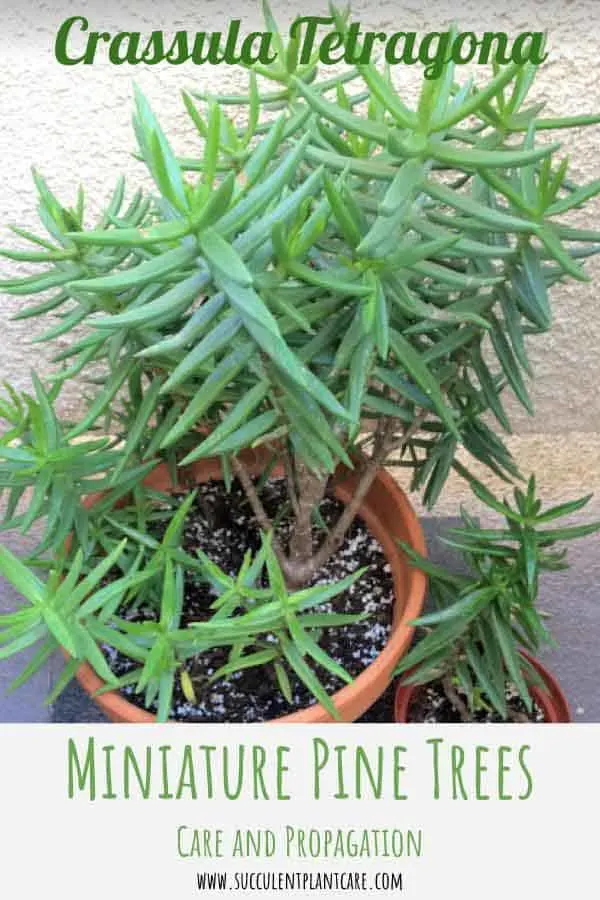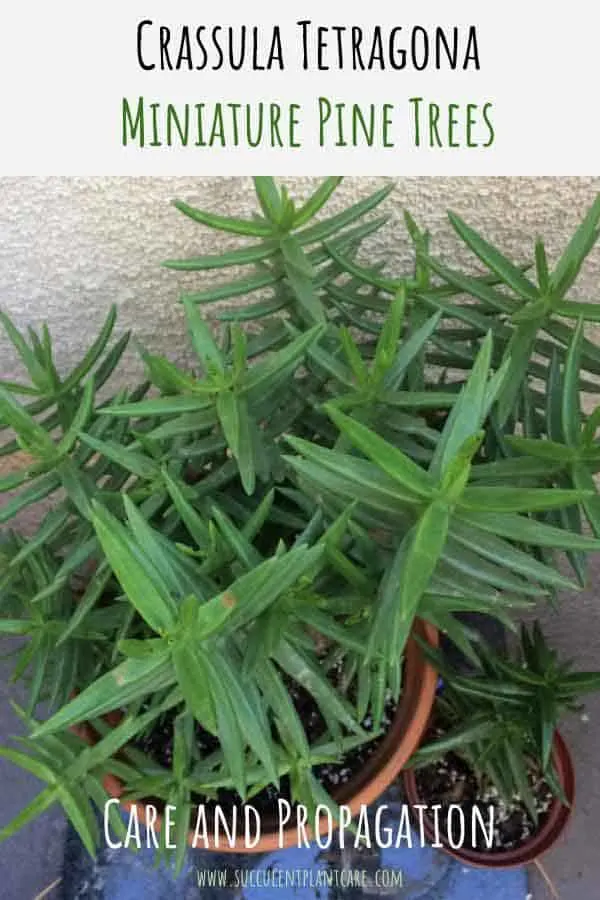When I first laid hold of a Crassula Tetragona ‘Mini Pine Tree’ plant, I didn’t know what to think. I received a tiny pot as a mother’s day gift from church. Each mother received a small 2-3 inch pot of some type of succulent plant and by chance, I was given a Crassula Tetragona plant.
I had secretly wanted one of the ‘prettier’ succulents with colorful rosettes and plump leaves. The Crassula Tetragona plant I received had thin, narrow leaves and stems. And the color was a uniform green from the stems to the leaves.
Of course, I have since changed my mind about this plant and have grown to love every part of it. These days, I have them growing all over my garden and have also given a lot away.

Native to South Africa, its common name pretty much describes how it looks. This miniature pine tree-looking succulents can grow up to 3-4 feet tall. They form shrubs and become tree-like as they grow.
The stem thickens, hardens and become darker and more ‘woody’ with age. They produce small white flowers that appear at the tips of the plant. These are very easy, low maintenance plants and in my opinion, one of the easiest ones to propagate from stem cuttings.
Caring for Crassula Tetragona
Are They Indoor or Outdoor Plants?
Crassula Tetragona is one of those plants that can grow happily both indoors and outdoors. Whether indoors or outdoors, provide the right potting mix (a well draining one) to give them the best chance at survival.
Indoor Lighting Requirements
Provide as much light as possible if kept indoors. Typically speaking, they need approximately 4-6 hours of light per day to thrive. Choose an east facing window if possible. A south or west facing window will also work.
You may need to move the plant around a few times in order to find the perfect spot. You may notice the plant stretching towards the light. This is called etiolation. It happens when the plant does not receive adequate light for prolonged periods of times. This process produces weak growth.
For areas with inadequate indoor lighting or poor lighting conditions, consider using a growlight. Growlights are a good investment to have especially if you have long, dark winters or if your area does not receive enough sunlight. Here are some of my growlight recommendations.
To read more about this topic on indoor lighting for succulents, check out my post on “Proper Lighting for Succulents Indoors” to get some helpful tips.
Outdoor Sunlight Requirements
Crassula Tetragona can tolerate a wide range of lighting conditions and will do well under partial shade to full sun. They will be happiest when provided plenty of bright, filtered sunlight. You need to acclimate the plant to full sun initially, especially baby plants.
Mild sunburn may be expected under extreme heat conditions. Move the plant to a shadier area during an intense heatwave to prevent sunburn or sun damage.
Before moving the plant outdoors or increasing the amount of sunlight it receives, it is better to acclimate the plant to prevent sunburn. Keep in mind that even when the plant is already acclimated to the sun, you still need to provide sun protection or shade during a heatwave or intense heat. They are hardy in USDA hardiness zones 9-11.
Sunshades are a real lifesaver for my plants during the intense summer heat here in Northern California where the sun can really scorch the plants if left unprotected. Here are some of my recommendations for sunshades and sun protection.
For further details and information on outdoor sunlight requirements, please visit my post “How Much Sunlight Do Succulents Need Outddoors?” to get some useful tidbits.
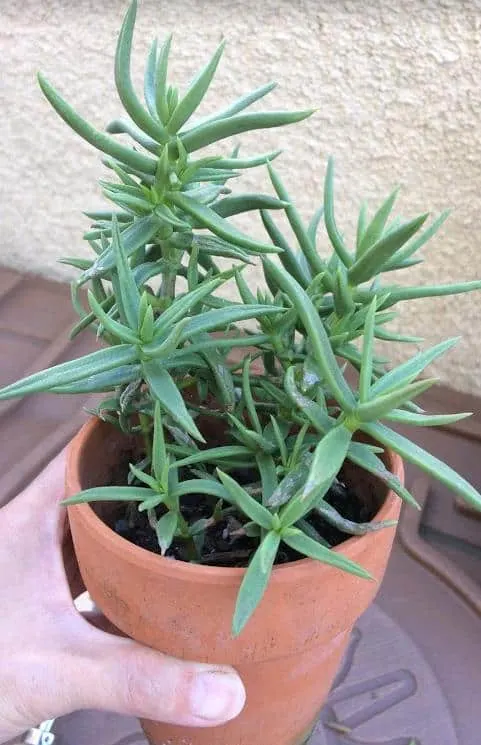
Frost Tolerance
Crassula Tetragona can tolerate mild frost and freezing temperatures as long as they are not for long periods of time. I keep all of mines outdoors all year long and they have been able to deal with mild frost, freezing temperatures, and winter rains. If you live in USDA hardiness zones 9-11, you can leave the plant outdoors all year long and they can even be planted in ground.
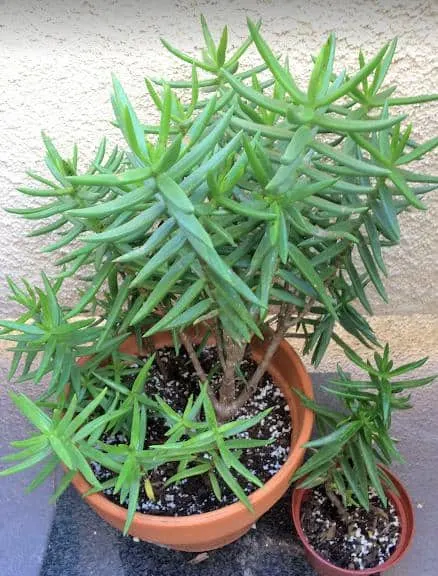
If you have extreme winter conditions in your area, the best way to grow these plants are in containers. That way you can bring them indoors during winter or when there is forecast of frost or snow.
If for whatever reason you cannot bring the plants in, there are ways to protect them from frost or freezing temperatures. You can use frost cloths or mini greenhouses to help them survive the cold winter. Here are some of my recommendations for frost protection.
For further information on this topic, click on my post “Optimal Temperatures for Succulents to Survive and Thrive”.
Soil Requirements
Just like with other succulent plants, Crassula Tetragona needs a well draining soil. I have been using a simple, tried and tested concoction that has worked well for my plants. I like to use a cactus potting mix combined with perlite for more drainage.
I do not use exact measurements but eyeball it to about 2:1 solution of cactus mix and perlite. Others recommend using a sandy soil. This can be achieved by mixing cactus mix or potting soil with coarse sand (about 2:1 ratio). Here are my soil recommendations. To read more about soil for succulents, click on “Best Soil and Fertilizer for Succulents” to get more useful information.
Watering Requirements
Watering largely depends on the climate where you live. Although these plants are highly adapted to dry weather conditions, they do much better when given sufficient but not too much water. There really isn’t a set schedule or formula on when to water succulents. I live in a very dry climate so my watering schedule is adapted to the dry conditions of my environment. In the summer months, I water my Crassula Tetragona as often as every 7-10 days, sometimes more during a heatwave. I cut back on watering to about every 10-14 days when the weather cools down.
If you live in a humid location, you won’t need to water as much. And if you keep your plants indoors, you may not have to water as much especially if they are not receiving a lot of light. Too much water and not enough light is a recipe for disaster for these plants. During the winter season, I mostly rely on rainwater and hold back on watering altogether because this is when we get a lot of rain in my area. But if we don’t get any rain at all during winter then I water at least once a month or every 2-3 weeks, depending on how dry the soil gets.
One good way to tell whether it’s time to water is to check the moisture of the soil. The top inch of the soil needs to feel dry before you can water again. If you are unsure how much and how often to water in the beginning, it’s always better to underwater and increase watering as needed. Pay attention to how your plant looks and you can adjust watering accordingly.
For further help with watering techniques, consider using tools like hygrometers or moisture meters to check for moisture in the soil and air. These tools are pretty affordable and can come in handy especially if you are unsure of when to water your plant next. I have narrowed down the choices here on my resource page. Do visit the page if you need help in gauging your watering needs.
Interested in finding out more about watering succulents? Visit my post “How And When To Water Succulents” where I go into details about this topic.
Propagating Crassula Tetragona
I find these plants very easy to propagate, so much so that I have given a bunch away. My preferred and only route in propagating is by stem cuttings. Propagate Crassula Tetragona from leaves is definitely doable, it just takes more time and patience. If you want to try to give leaf propagation a try, make sure to use the whole leaf including the base to ensure success. Rooting a leaf cutting is similar to stem cutting, it just takes longer.
Propagating from stem cuttings:
- Obtain a stem cutting and let it dry for a day or so. Since the stems are thin they shouldn’t take that long to dry.
(Optional) Dip the cut end in rooting hormone. I usually skip this step but some people prefer using rooting hormones to speed up the process and also guarantee success.
- Once the cut has healed and dried, stick the cuttings in a well draining potting mix.
- Keep away from direct sunlight. Water the soil every few days or when it feels dry.
- After about two weeks or so, you will notice new roots growing.
- After about four to six weeks, the cuttings should be fully rooted and you will soon notice new growth developing from the top or the sides along the stem.
There you have it. It is very easy to propagate these plants from stem cuttings. In fact, I have them growing everywhere and use them as fillers in a lot of my pots. I have also given a lot away to friends. I wrote about how I have grown my succulent collection through stem cuttings here “Easiest Way to Propagate Succulents”. It really is such a rewarding experience to be able to multiply your collection and have them literally growing everywhere.
Common Problems with Growing Crassula Tetragona
Brown Leaves
The most common cause of brown leaves on Crassula Tetragona is sunburn. Although this plant can take full sun, any extreme weather conditions or extreme changes in weather such as a heatwave can cause sunburn or sun damage. This does not really internally hurt the plant as long as the problem is temporary. Prolonged sunburn under extreme heat can literally scorch the plant to death. If you notice the plant constantly getting sunburned, move the plant to a shadier location or provide shade under taller plants, furniture, or sun shades. If moving the plant to a sunnier spot, it is a good idea to do so slowly so you don’t shock the plant and stress it too much. Gradual changes are always better than drastic ones for any succulent plant.
Shriveled Leaves
The most common reason for shriveled leaves on Crassula Tetragona is underwatering. The leaves will appear shriveled, droopy and dried up. When touched, the leaves will feel flat and deflated. When this happens, it is usually a sign that the plant is running low on its water storage and it is time to water. If this is the case, give the plant a good drink of water and it should perk up immediately, usually within a day or so.
Mushy Brown Leaves
The most common reason for mushy brown leaves on Crassula Tetragona is overwatering. The plant will look unwell and will feel soft and mushy to touch. These are usually signs you are overwatering your plant. Simply cut back on watering and allow the plant to dry out and recover from too much water. Do not water until the plant has had a chance to dry out completely. If the soil is not drying out fast enough, consider switching to a fast draining one. If left in wet soil, root rot can set in. Once you notice rot, you can still save the plant by cutting off all the dead parts of the plant. Save anything that looks green and viable to propagate and repot.
Remember, it is easier to ‘fix’ an underwatered plant than an overwatered one so when in doubt, err on the side of caution when watering.

Pictures of shriveled leaves from underwatering and brown spots from sunburn.
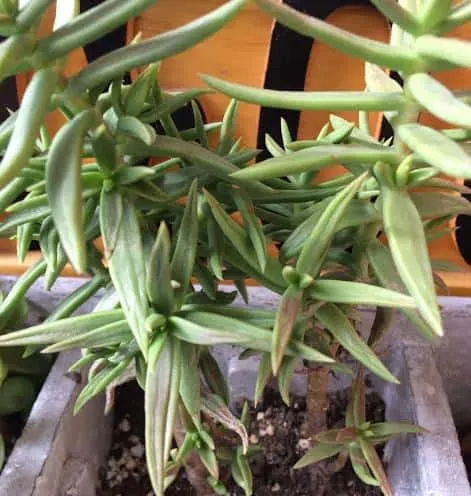
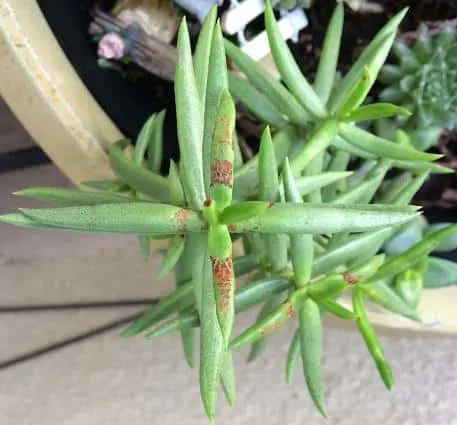
Crassula Tetragona Blooms
Crassula Tetragona produces white or yellow flowers that grow from the tips of the plant in spring and early summer. To encourage blooms, make sure they are receiving adequate lighting. Along with proper lighting, make sure the plant is kept happy and receiving the proper care as mentioned above.
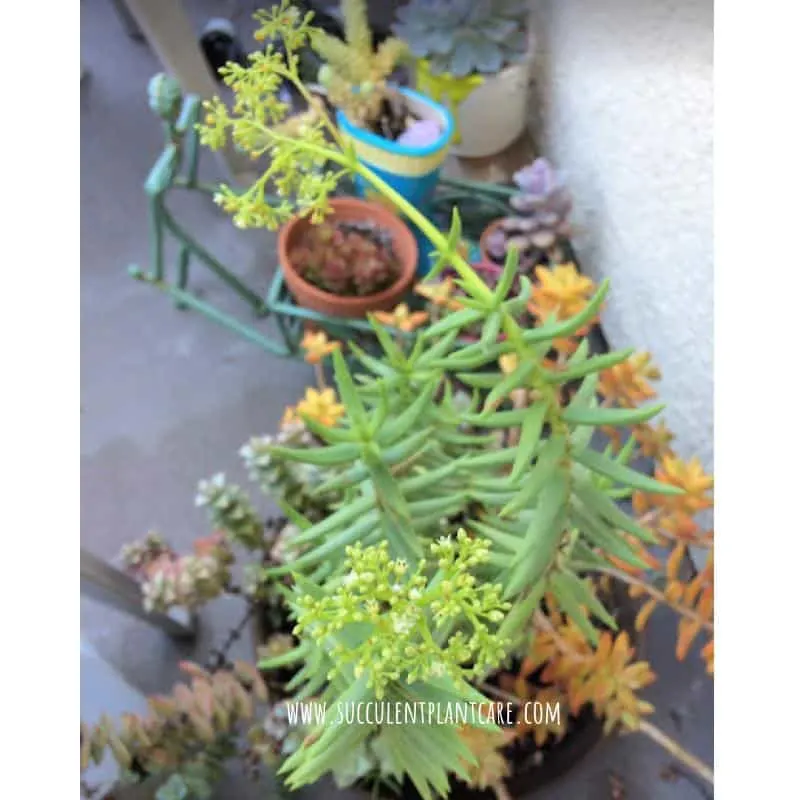
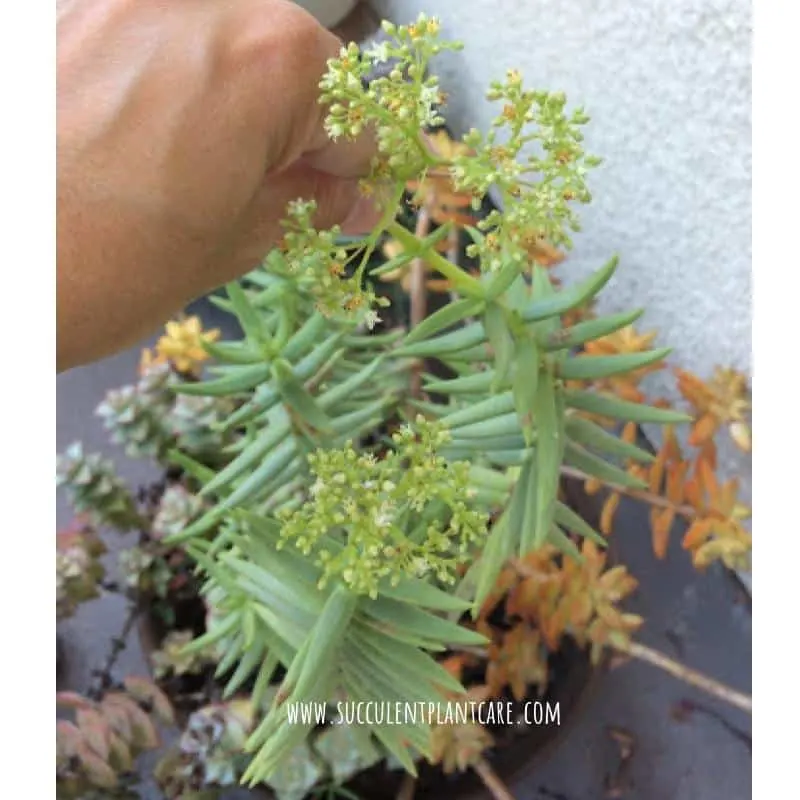
While fertilizing is not necessary, giving your plants the nutrients they need will help ensure proper growth and encourage blooms. It takes a lot of energy for plants to produce flowers, and feeding them extra nutrients will help supplement their needs during flowering season. The best time to fertilize is during the active growing season, or during spring and summer months. A balanced blend of fertilizer for houseplants or a fertilizer specially formulated for cacti and succulents are suitable. Fertilizers are better applied at a quarter or half strength, about every two weeks. Here are some fertilizers I recommend.
Along with the right environmental conditions, they also need to go through a wintering period to encourage blooms. This can be achieved by keeping them cool and dry in the winter months, with temperatures just above freezing between 35-44⁰F (1.5-7⁰C).
Toxicity to Cats, Dogs or Pets
Crassula Tetragona are not considered toxic to dogs, cats or pets. The ASPCA’s (American Society for the Prevention of Cruelty to Animals) website provides valuable information and a comprehensive list of toxic and nontoxic plants for cats, dogs, and other house pets. If you suspect poisoning, contact your local veterinarian immediately or the ASPCA Animal Poison Control Center at 888-426-4435.
When you get a chance to own one of these amazing plants, do not pass it up. I guarantee that you will grow to love them and enjoy them for many years to come.
When you get a chance to own one of these amazing plants, do not pass it up. I guarantee that you will grow to love them and enjoy them for many years to come.
Where can you find Crassula Tetragona ‘Miniature Pine Trees’? Check out my resource page for recommendations on where to purchase these and other succulent plants online.
Pin this post to save for yourself or share with others!
